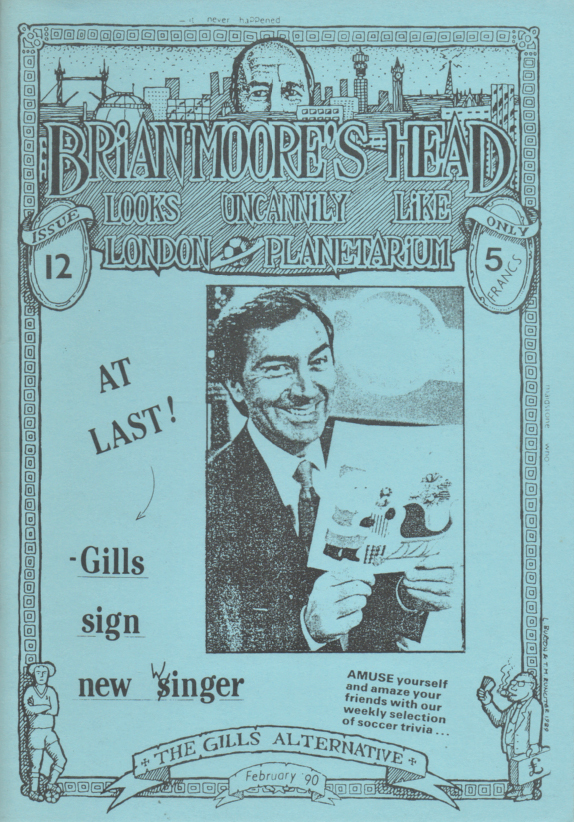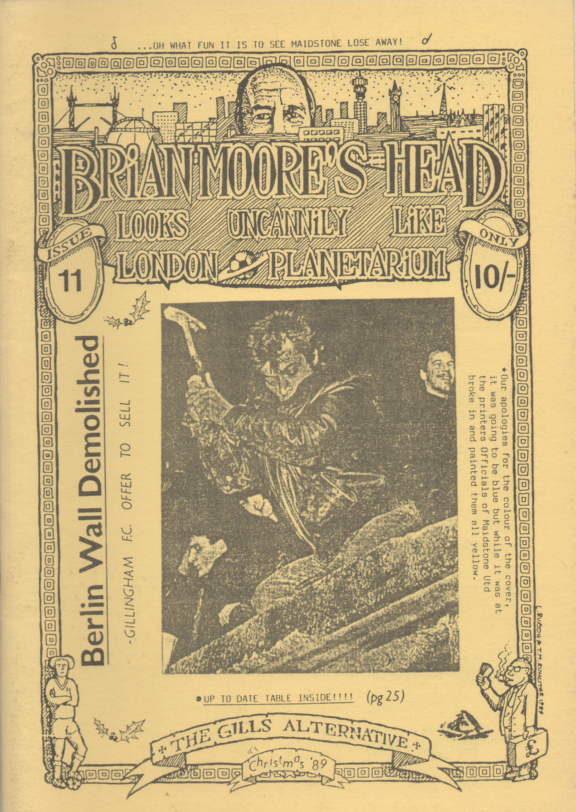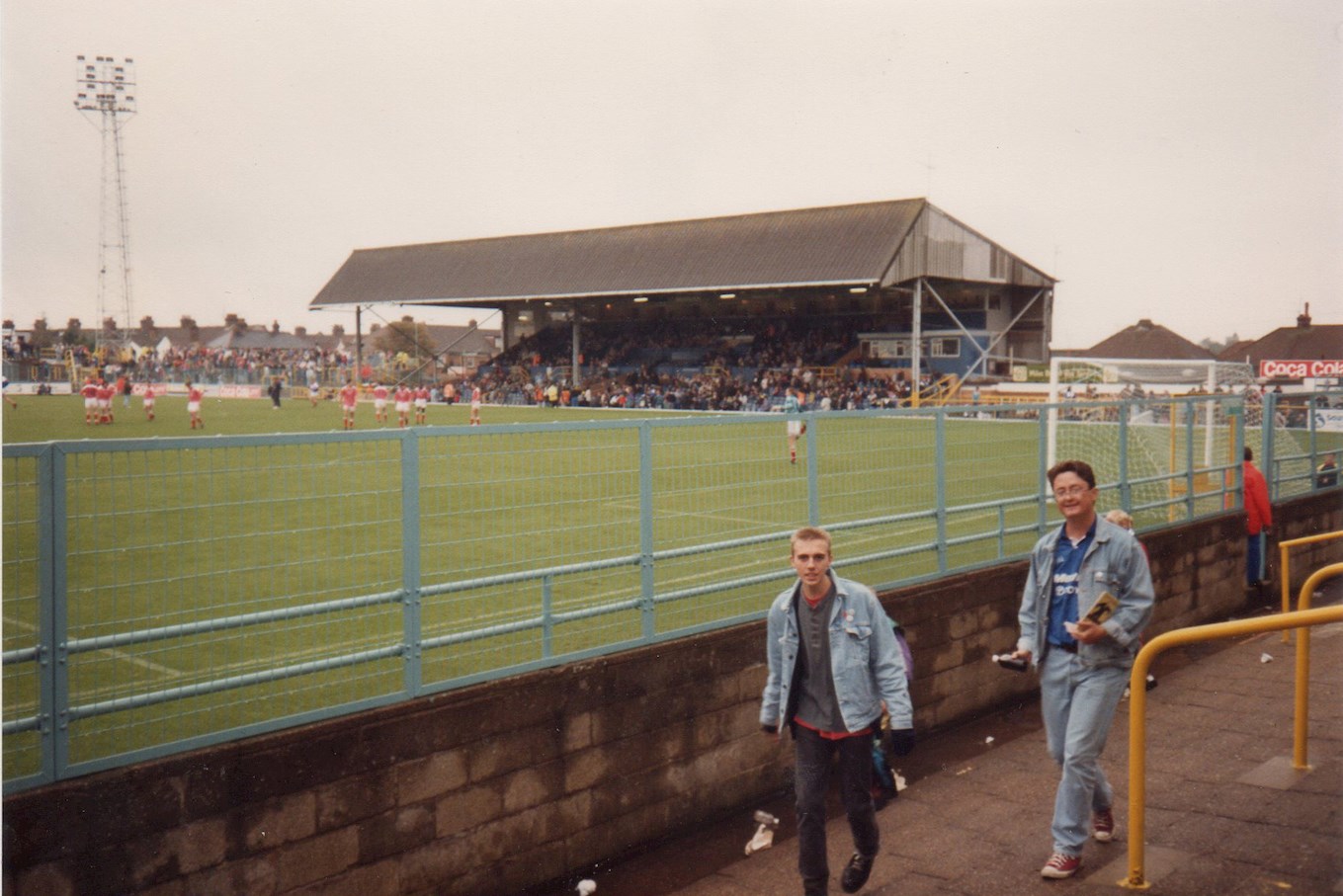Andy Ford's series continues.
Boxing Day 1989 not only saw the first all-Kent Football League derby, with Maidstone United visiting Priestfield and showing a blatant disregard for the county’s number one team by departing with all three points, courtesy of a 2-1 victory, but it was also the day that BMH issue eleven was launched.
Mindful of the fact that the game would attract a large attendance, the fanzine team upped the print-run to 1,200 copies. The attendance figure given out was 10,412, conveniently just below Priestfield’s capacity in those days of 10,500, although many felt that the true gate was in the region of 12,000.
The previous home match, despite being a local fixture against Colchester United, had only attracted 3,816, whilst the next fixture at Priestfield following the Maidstone encounter, three days later, saw just 3,733 come through the turnstiles for the visit of Wrexham.
With such a large crowd on Boxing Day, sales of BMH were brisk, but with all the part-timers turning up, there were more fans than usual who confused the fanzine with the matchday programme. We tended to sell each edition of the fanzine at three home games, and after the third match at which we’d been trying to shift issue eleven, the 3-1 victory over Doncaster on 13 January 1990, only 25 of the 1,200 copies of BMH11 remained unsold.
Earlier in the season, the Brian Moore’s Head team had been invited to meet some of the club’s hierarchy, a request that was readily agreed to, with the meeting taking place in the convivial surroundings of a local pub, prior to the home match against Chesterfield towards the end of October. Local daily newspaper, The Evening Post, expressed their reservations about the BMH boys’ liaison with those running the football club, suggesting that if we were ‘accepted into the fold’, then we risked losing our independence, but that was never going to happen.
An article on the meeting subsequently appeared in issue eleven of BMH. High on the agenda was a possible ground move away from Priestfield, which Managing Director Tony Smith said was definitely going to happen. Accountant Phil Giles maintained that a stadium move needed to take place if Gillingham were to progress from being a lower league club to a division two (in those days, the second tier of English football) outfit. Smith assured us that any new ground would be within the borough of Gillingham, would not be all-seater and would have terracing behind both goals.

We were told of the various difficulties involved in running Priestfield, with the Fire Officer a thorn in the side of the club. He’d apparently insisted that a new perimeter wall had to be built around the ground before the start of the following campaign. The Gordon Road Stand had been taken out of use in 1985, following the fire at Bradford’s Valley Parade ground, as it was made of wood, and we asked why that area of the ground hadn’t been redeveloped, over four years later. The response was that the Fire Officer wanted two new exits and a first-aid room.
Priestfield still had high perimeter fences at the time, despite the fact that it had been such monstrosities that had been responsible for the deaths of many fans at Hillsborough earlier that year, a disaster that prompted many clubs, that still had fences, to tear them down. When BMH asked why we still had fencing and whether it would be removed, the response was disappointing, with the club’s view that fences were necessary in order to keep the minority of idiots in order.
The author of the article wrote, ‘In an ideal world, all fences would have been torn down after Hillsborough, unfortunately it’s not an ideal world and the actions of a few brain-dead zombies immediately after the tragedy gave the F.A., the League and the Police enough reason to justify their continued existence. This is another advantage of starting from scratch, surely the design of a new ground could incorporate a moat into the plans, thus allowing for a virtually fence-free stadium.’
Tony Smith, who almost single-handedly kept the club afloat during the early nineties, came across as a thoroughly decent person and he was always happy to have a chat with the fanzine team, with one notable example coming during the 1992-3 season, when the BMH squad and Smith were on the same train from Victoria to the Medway Towns, as we all made our way back from a 1-0 defeat at Carlisle. Tony, even though he wasn’t travelling on his own, came down for a chat and sat with us for the whole journey.
The ‘Own Goal XI’ included such illustrious figures as Steve Bruce and Tony Cascarino. The former was, ‘Undoubtedly the best defender at the club in recent years, he still had an uncanny knack of scoring own goals. The most memorable was probably one off the back of his neck in the 3-3 draw with Millwall in 1983, but he could use virtually any part of his anatomy. Marked his debut for Norwich by heading Liverpool into the lead after two minutes.’ As for Cascarino, ‘Rarely misdirected his headers, but this one was supposed to be a clearance from a corner. However, from his position on the edge of the area, he sent a glorious looping header beyond Hillyard.’
The resident ‘expert’ made another appearance, with his somewhat radical views as to how the national team could rule supreme once again, ‘The only way for England to once again become the best Association Football team in the world would be if the government re-introduced food rationing, and historical evidence backs up my view. During the last period of food rationing in the forties and fifties, people like Bobby Charlton, Geoff Hurst and Nobby Stiles were growing up, and I believe that food rationing helped them to become the great players that formed the focal point of Sir Alf’s England team which gloriously defeated the world in 1966.’ He suggested that modern players had it too easy, with pre-match steaks and ‘Paul Gascoigne eating twenty Mars bars a day’, and that the good living made players complacent.
The expert concluded his piece with, ‘There will undoubtedly be some people who will ask why fifty four million UK inhabitants should suffer food rationing for the sake of the future of the England team and another World Cup win. To these people I say, you need only look back to Sir Alf’s team gloriously defeating the world in 1966. To see a repeat of that, food rationing for a few years would be a small price to pay.’ After the expert’s wife had penned a column in the previous edition, his daughter got in on the act, thanking her father for buying her a Subbuteo World Cup set for Christmas and vehemently denying that she was disappointed not to have received a Barbie doll.

Issue 12 of Brian Moore’s Head contained the inevitable post-mortem on our Boxing Day defeat by Maidstone. The author of the piece wrote that, whilst queuing up outside, he was accosted by a grinning Nick Collins, now on Sky Sports, but, in those days, a reporter on local independent television company Television South, and a TVS cameraman. Collins ‘asked me who I thought would win on “this historic occasion”, I said that, as a big crowd had turned up, we’d probably get stuffed.’ The article concluded with, ‘I hate to say it, but they deserved to win. The days when we can go to their place and win 8-0 in friendlies, as we did in ’85, are long gone.
Just as in the Cup ties of 1980, they outfought and out-thought us at Priestfield. All very embarrassing, and this, coupled with the Welling adventure, makes our claim to be Kent’s premier club seem rather trivial. Ashford probably can’t wait for their Kent Cup clash.’ Welling were the Kent non-league side that had knocked the Gills out of the FA Cup earlier that season.
The editorial commented on the decision made by Gillingham to increase the price of the programme for Maidstone’s visit from 80p to £1, ‘Had the club produced a special issue, no-one could have complained, but, no, all we got was a pathetic little asterisk containing the words, “First All-Kent Football League Game”. Really, well I hadn’t realised that. Okay, so the club could point out that there was a voucher for 20p off the next programme inside, but how many people are prepared to cut great lumps out of their programme for the sake of 20p? I was later informed that you could have presented the whole thing intact, did you know that? It wasn’t made clear. To those of us who supported the club throughout the dark days of last season, this was a total stab in the back, I thought the club had gone beyond treating supporters like this, whoever made the decision to rip us off should be ashamed of themselves.’
With a new decade having just started, the fanzine looked back to the previous one, with an article titled, ‘Stupid Things We Did In The Eighties’. These included, ‘Bought a ticket for a friendly at Chatham because George Best was playing – one of us didn’t turn up’, in 1980, and two years later, ‘Asked John Motson for his autograph before the televised game with Fulham (he trod on my scarf while clambering over the wall).’ One of 1983’s offerings was, ‘Stuck a Ray Clemence Panini sticker in a maths exercise book – my maths teacher was one Mr Jones (only those who attended Rochester Math School can possibly appreciate that the last thing you did when you had Mr Jones was stick Panini stickers in maths books)’, whilst 1986’s selections included, ‘Fell off a train at Charing Cross, thanks to an untied shoelace, while travelling to a Freight Rover Trophy Final’ and ‘Watched France v Canada in the World Cup at 2am, with a geography ‘O’ Level seven hours later.’
The ‘expert’ was back again, with his column in issue eleven devoted to the ladies, ‘I find myself becoming increasingly agitated with women. Not only do some of these so-called members of the opposite sex expect to be allowed within the confines of our stadia, they want to play the game as well.’ He went on to ask whether England would have won the World Cup in 1966 if Sir Alf Ramsey had been a woman or if Manchester United would have triumphed in the 1968 European Cup Final if they had had a Georgina Best in their side. The article continued with, ‘We have all heard of the saying “Chained to the kitchen sink”, well I believe this is precisely what should happen to those people who, when all is said and done, are not of the male persuasion. Surely any decent law-abiding member of the female gender would have no objection to being restrained in this manner, obviously the chain would be long enough to enable them to move around the kitchen and prepare their menfolk’s meals, after all, we’re not barbarians.’

The somewhat inflammatory content of the piece led to a text box being placed over the picture of the expert above his column, that read, ‘The entire editorial team wish to dis-associate themselves from the opinions of this individual.’
Issue eleven also contained the news that many fans had been hoping for, ‘Against all the odds, we won. The ill-conceived plans to impose ID cards upon us appears to have been dropped, but make no mistake about it, there is one reason and one reason alone for the Government’s change of heart – the Justice Taylor enquiry predictably coming out against the scheme was the death knell for one of the most unjust pieces of legislation yet devised by a government well used to devising unjust pieces of legislation. However, a note of caution – the Bill will remain on the statute books, given half a chance the Tories will revive it.’ The Taylor Report had come about as a result of the Hillsborough disaster in 1989.
There was no let up in the ‘elevens’ that graced the pages in BMH, with issue eleven boasting no less than four, as the concept was milked for all that it was worth. There was the ‘Team of the Eighties versus the Donkeys of the Decade’, with Dave Shearer, who was described as being somewhat broken down and overweight, ‘but he still managed to find the net on a regular basis, and in a style which always endeared him to the fans’, in the former, and, in the latter, Derek Hales, ‘In his heyday, he was undoubtedly one of the most-feared strikers in the league. Unfortunately, his heyday was about ten years before he joined us.
Originally an apprentice at Gillingham, has to be entered, along with Peter Beardsley, in the ones that got away column.’ The ‘Out of Position XI’ included Paul Haylock in goal, the right-back having taken over between the sticks following Phil Kite’s red card in a League Cup tie at Brighton in 1987, and, at left back, midfielder Colin Duncan, ‘The opening day of the 1983-4 season, Duncan, making his first and only appearance at left back, sees Sheffield United romp to a 4-0 win. Duncan never played for the team again.’ The ‘They returned in strange colours XI’ was populated with former players coming back to Priestfield with other sides, including four of the Maidstone team that had won 2-1 at Gillingham in the Boxing Day clash.
The back page of issue twelve was the first of the fanzine’s ‘Cover Stars’, Brian Moore deservedly kicking off what was either a worthwhile feature or a blatant space-filler.
